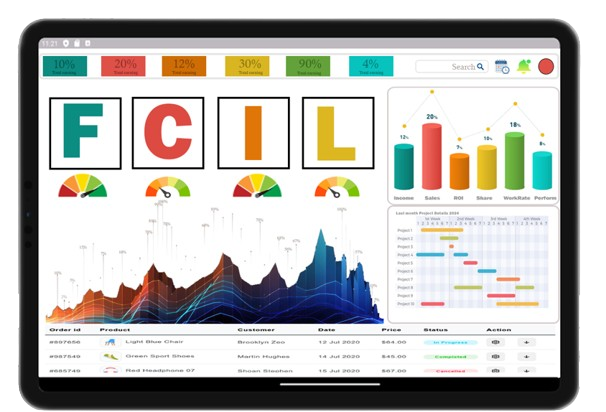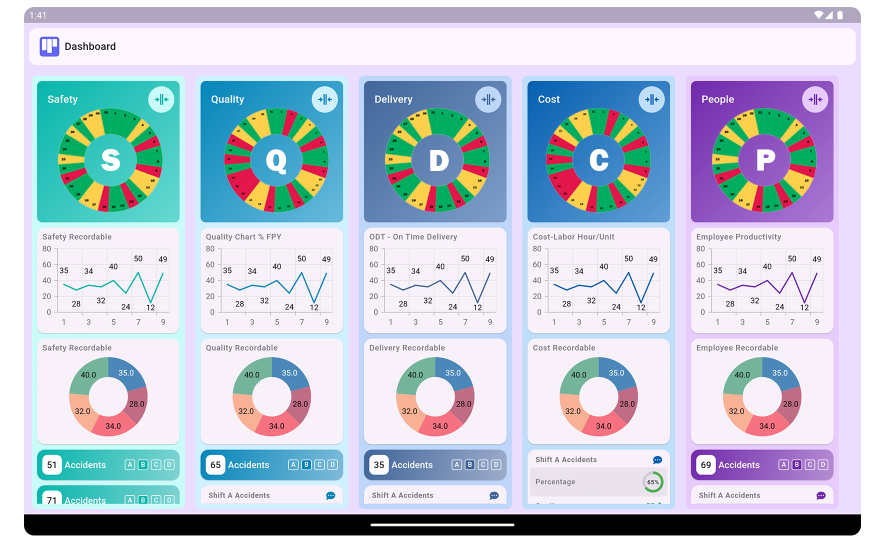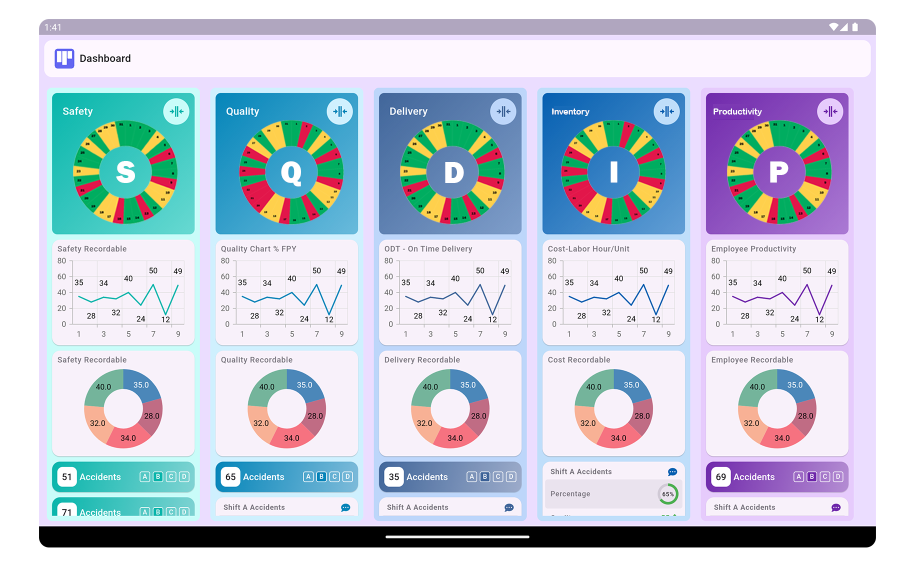In manufacturing and production, achieving high-quality output, efficient processes, and safety requires a strategic approach to performance management. The Balanced Scorecard (BSC) framework offers a structured way to measure and improve performance across critical areas by setting objectives, defining metrics, and continuously tracking progress. Several specialized BSC frameworks have emerged for manufacturing, each addressing the industry's unique demands through different performance areas, such as quality, cost, delivery, and safety.
Core Components of Balanced Scorecard Frameworks in Manufacturing
The manufacturing-focused BSC frameworks typically revolve around key performance areas like Safety, Quality, Delivery, Cost, and other relevant factors. The goal of these frameworks is to balance these often-competing objectives so that improvements in one area do not negatively impact another.
1. FCIL (Flow, Cost, Inventory, Lead Time)

Flow: Ensures that materials, parts, and information move smoothly through the production process. This is often measured by looking at metrics like production cycle time, setup time, and bottlenecks. Improving flow reduces idle time, maximizes machine utilization, and improves productivity.
Cost: Focuses on maintaining cost efficiency across production. Cost metrics track expenses related to materials, labor, equipment maintenance, and utilities. Controlling costs without sacrificing quality is essential in maintaining a competitive edge.
Inventory: Manages raw materials, work-in-progress, and finished goods to optimize stock levels. Metrics here track inventory turnover, holding costs, and stockouts. Optimal inventory levels minimize waste and reduce storage costs.
Lead Time: Measures the time it takes from order to delivery, including production and transportation times. Reducing lead time improves delivery reliability, helping meet customer demand promptly.
2. SQDC (Safety, Quality, Delivery, Cost)

Safety: Prioritizes the health and safety of workers. Safety metrics include incident rates, near-miss reports, and compliance with safety regulations. A focus on safety reduces accidents, fosters a positive work culture, and ensures a safer work environment.
Quality: Ensures that products meet required standards and are defect-free. Quality metrics include defect rates, first-pass yield, and warranty claims. High-quality products enhance customer satisfaction and reduce rework and waste.
Delivery: Focuses on meeting delivery deadlines and reliability. Delivery metrics include on-time delivery rate, order fill rate, and delivery accuracy. Meeting delivery targets builds customer trust and supports long-term relationships.
Cost: Tracks and controls costs in production. Cost metrics include production costs, waste reduction, and cost per unit. Maintaining cost efficiency while ensuring quality and reliability is vital to competitiveness.
3. SQDCP (Safety, Quality, Delivery, Cost, People)

People: Recognizes the importance of employee development, engagement, and satisfaction. People-related metrics might include training hours, skill development, absenteeism rates, and employee engagement scores. A focus on people creates a motivated and skilled workforce, reducing turnover and enhancing productivity.
Building on the SQDC framework, SQDCP adds “People” as a vital component, acknowledging that skilled, engaged, and safe employees are foundational to manufacturing success. High-performing teams contribute to better results across the other dimensions of safety, quality, delivery, and cost.
4. SQCDL (Safety, Quality, Cost, Delivery, Lead Time)

Lead Time: Prioritizes minimizing the time taken from production start to customer delivery. Reducing lead times improves responsiveness to customer demand and enhances competitive advantage.
Similar to SQDC, SQCDL includes Lead Time to emphasize responsiveness and customer satisfaction. Reducing lead times can create a more agile production system capable of adapting to shifts in customer demand without sacrificing quality or safety.
5. SQDIP (Safety, Quality, Delivery, Inventory, Productivity)

Inventory: Tracks inventory management to optimize stock levels, reducing waste and storage costs. Effective inventory control prevents excess stock and stockouts.
Productivity: Measures efficiency in terms of output per unit of input. Productivity metrics include labor productivity, machine utilization, and downtime. Higher productivity leads to increased output and cost savings.
SQDIP incorporates Inventory and Productivity into the traditional SQDC framework. This enables a more comprehensive approach, focusing on not just the end results of quality and delivery but also the efficiency and resourcefulness of the production process.
6. QCDMS (Quality, Cost, Delivery, Morale, Safety)

Morale: Focuses on employee satisfaction and engagement. Morale metrics include job satisfaction, absenteeism, and turnover rates. High morale leads to greater productivity and lower turnover, creating a more stable workforce.
The QCDMS framework adds “Morale” to Quality, Cost, Delivery, and Safety. This highlights the importance of employee well-being and satisfaction, acknowledging that motivated employees are more likely to contribute positively to quality, efficiency, and safety efforts.
7. SQDCME (Safety, Quality, Delivery, Cost, Morale, Environment)
Environment: Tracks environmental impact, focusing on waste reduction, energy use, and compliance with environmental regulations. Environmental metrics include carbon footprint, waste disposal costs, and energy consumption.
Building on QCDMS, the SQDCME framework includes “Environment” as a critical factor. Environmental performance is increasingly significant, with many companies aiming to reduce their ecological impact. This framework encourages manufacturers to consider sustainability alongside traditional metrics, promoting a responsible and eco-friendly production approach.
Benefits of Using BSC Frameworks in Manufacturing
1. Holistic Performance Management
By using frameworks like SQDC, SQDCP, or QCDMS, organizations can track a balanced range of performance metrics. These frameworks ensure that improvement in one area does not come at the expense of another. For example, focusing only on reducing costs without regard to quality could harm product standards. With a balanced approach, companies can aim for improvement across safety, quality, delivery, and cost simultaneously.
2. Continuous Improvement
These frameworks align well with continuous improvement methodologies, such as Lean and Six Sigma, by providing metrics that track waste reduction, quality improvements, and process efficiency. Regularly monitoring and adjusting strategies based on these metrics leads to incremental improvements that, over time, have a significant impact on performance.
3. Enhanced Employee Engagement
Frameworks that include people-related metrics, such as SQDCP, QCDMS, and SQDCME, help organizations recognize and address employee needs. By focusing on morale, safety, and development, these frameworks create a more supportive work environment that increases job satisfaction and reduces turnover.
4. Responsiveness to Customer Needs
Metrics related to delivery, lead time, and quality enable companies to better meet customer expectations. By tracking these areas, manufacturers can quickly respond to customer demands and market changes, improving customer satisfaction and loyalty.
5. Sustainability and Environmental Responsibility
Frameworks that include environmental metrics, like SQDCME, support sustainable manufacturing practices. By focusing on environmental impact, manufacturers can reduce waste, lower energy consumption, and comply with environmental regulations, which aligns with broader industry trends toward sustainable production.
6. Data-Driven Decision-Making
These frameworks provide actionable data that helps managers make informed decisions. Instead of relying on assumptions, teams can refer to metrics within their chosen framework to identify trends, troubleshoot issues, and prioritize actions. This objective approach supports more effective problem-solving and planning.
Balanced Scorecard Framework
What is the balanced scorecard framework?
The balanced scorecard framework is a tool for tracking multiple performance areas, helping organizations align operational activities with strategic goals. It often focuses on quality, cost, delivery, and safety metrics.
How does the FCIL framework function in a balanced scorecard?
FCIL stands for Flow, Cost, Inventory, and Lead time. It tracks workflow efficiency, cost control, inventory levels, and delivery times, helping teams optimize production flow and reduce costs.
What is the purpose of SQDC in performance tracking?
SQDC stands for Safety, Quality, Delivery, and Cost, focusing on these four key areas to help organizations prioritize safety, maintain quality standards, ensure timely delivery, and control costs.
How does SQDCP differ from SQDC?
SQDCP adds "Productivity" to the standard Safety, Quality, Delivery, and Cost metrics, emphasizing efficiency in operations and resource usage to boost overall productivity alongside other goals.
What does SQCDL stand for in the balanced scorecard framework?
SQCDL represents Safety, Quality, Cost, Delivery, and Lead time. It combines traditional metrics with lead time tracking, enabling teams to focus on timely production and delivery schedules.
How does SQDIP framework benefit production teams?
SQDIP stands for Safety, Quality, Delivery, Inventory, and Productivity, giving production teams a comprehensive view of operational performance, including inventory levels, for better resource management.
What KPIs are included in the QCDMS framework?
QCDMS stands for Quality, Cost, Delivery, Morale, and Safety, and includes KPIs that track these aspects, helping organizations create a balanced approach to operational performance and team morale.
How does SQDCME improve monitoring in manufacturing?
SQDCME adds Environment to Safety, Quality, Delivery, Cost, and Morale, ensuring teams monitor environmental impact alongside other metrics, helping companies meet sustainability goals in production.
Can these frameworks be combined within one balanced scorecard?
Yes, many organizations combine elements from different frameworks to create a custom scorecard that best meets their performance tracking needs, allowing for tailored KPI selection and monitoring.
How do SQDC-based frameworks improve quality control?
By consistently tracking quality metrics, SQDC-based frameworks help teams identify quality issues early, implement corrective actions, and ensure products meet specified standards.
Why is cost tracking included in balanced scorecard frameworks?
Cost tracking helps organizations monitor spending, reduce waste, and ensure budget adherence, all essential for maintaining profitability without sacrificing quality or safety.
Can morale metrics be measured in SQDC-based frameworks?
Yes, frameworks like QCDMS and SQDCME include morale, assessing employee satisfaction and engagement levels, which contribute to improved productivity, retention, and workplace culture.
How does the SQDIP framework enhance delivery performance?
SQDIP enables tracking of delivery times, safety, and productivity metrics, allowing teams to optimize processes for on-time deliveries while maintaining product quality and workplace safety.
What is the role of continuous improvement in QCDMS?
Continuous improvement in QCDMS focuses on enhancing quality, lowering costs, and increasing morale through regular assessments, helping teams refine processes and meet evolving production goals.
Are balanced scorecard frameworks applicable to non-manufacturing industries?
Yes, frameworks like SQDC can be adapted to various sectors by tailoring KPIs. This allows organizations in diverse industries to monitor and improve performance in areas such as service quality and cost.